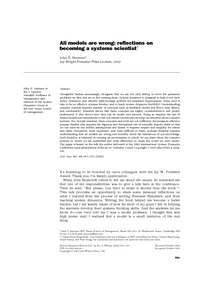All models are wrongreflections on becoming a systems scientist
John D. Sterman
Erstpublikation in: System Dynamics Review Vol. 18, No. 4, (Winter 2002): 501–531
Publikationsdatum:
|
 |
 Diese Seite wurde seit 6 Jahren inhaltlich nicht mehr aktualisiert.
Unter Umständen ist sie nicht mehr aktuell.
Diese Seite wurde seit 6 Jahren inhaltlich nicht mehr aktualisiert.
Unter Umständen ist sie nicht mehr aktuell.
 Zusammenfassungen
Zusammenfassungen
Thoughtful leaders increasingly recognize that we are not only failing to solve the persistent
problems we face, but are in fact causing them. System dynamics is designed to help avoid such
policy resistance and identify high-leverage policies for sustained improvement. What does it
take to be an effective systems thinker, and to teach system dynamics fruitfully? Understanding
complex systems requires mastery of concepts such as feedback, stocks and flows, time delays,
and nonlinearity. Research shows that these concepts are highly counterintuitive and poorly
understood. It also shows how they can be taught and learned. Doing so requires the use of
formal models and simulations to test our mental models and develop our intuition about complex
systems. Yet, though essential, these concepts and tools are not sufficient. Becoming an effective
systems thinker also requires the rigorous and disciplined use of scientific inquiry skills so that
we can uncover our hidden assumptions and biases. It requires respect and empathy for others
and other viewpoints. Most important, and most difficult to learn, systems thinking requires
understanding that all models are wrong and humility about the limitations of our knowledge.
Such humility is essential in creating an environment in which we can learn about the complex
systems in which we are embedded and work effectively to create the world we truly desire.
The paper is based on the talk the author delivered at the 2002 International System Dynamics
Conference upon presentation of the JayW. Forrester Award.
Von Klappentext im Text All models are wrong (2002)  Dieser Text erwähnt ...
Dieser Text erwähnt ...
 Personen KB IB clear | William Behrens , Linda Booth Sweeneya , Jay Forrester , Donella Meadows , Dennis Meadows , Günther Ossimitz , Jørgen Randers , Peter M. Senge , John D. Sterman | ||||||||||||||||||||||||||||||||||||||||||||||||||||||
 Begriffe KB IB clear |  Denken Denken thinking
, scientific literacyscientific literacy
, Systemsystem
, system dynamicssystem dynamics
, Systemdenkensystems thinking thinking
, scientific literacyscientific literacy
, Systemsystem
, system dynamicssystem dynamics
, Systemdenkensystems thinking
| ||||||||||||||||||||||||||||||||||||||||||||||||||||||
 Bücher |
| ||||||||||||||||||||||||||||||||||||||||||||||||||||||
 Texte |
|
 Tagcloud
Tagcloud
 Zitationsgraph
Zitationsgraph
 Zitationsgraph (Beta-Test mit vis.js)
Zitationsgraph (Beta-Test mit vis.js)
 Volltext dieses Dokuments
Volltext dieses Dokuments
 |  All models are wrong: Artikel als Volltext ( All models are wrong: Artikel als Volltext ( : :  , 181 kByte; , 181 kByte;  : :  Link unterbrochen? Letzte Überprüfung: 2020-11-28 Letzte erfolgreiche Überprüfung: 2018-11-28) Link unterbrochen? Letzte Überprüfung: 2020-11-28 Letzte erfolgreiche Überprüfung: 2018-11-28) |
 Externe Links
Externe Links
 Volltext : All models are wrong: ( Volltext : All models are wrong: (  : :  2021-03-21) 2021-03-21) |
 Anderswo suchen
Anderswo suchen 
 Beat und dieser Text
Beat und dieser Text
Beat war Co-Leiter des ICT-Kompetenzzentrums TOP während er Dieser Text ins Biblionetz aufgenommen hat. Die bisher letzte Bearbeitung erfolgte während seiner Zeit am Institut für Medien und Schule. Beat besitzt kein physisches, aber ein digitales Exemplar. Eine digitale Version ist auf dem Internet verfügbar (s.o.). Es gibt bisher nur wenige Objekte im Biblionetz, die dieses Werk zitieren.









 (
(


 Biblionetz-History
Biblionetz-History